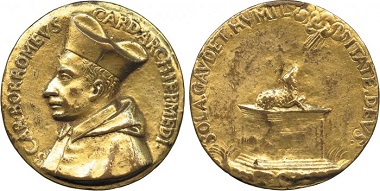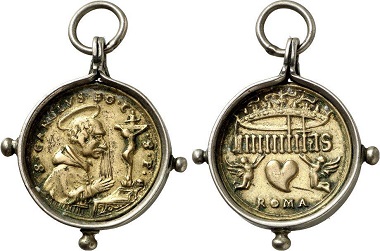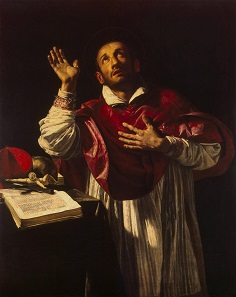translated by Annika Backe
In addition to the founder of the Jesuits, Ignatius of Loyola, Saint Charles Borromeo is probably the saint mentioned most often with regards to the exemplary implementation of the church reform after the Council of Trent. Here we tell his story as mirrored in the numismatic testimonies.
Charles Borromeo. Medal, 1601-1610. Charles Borromeo in the priestly attire with biretta. Rv. Lamb on altar. Inscription SOLA GAVDET HVMILITATE DEVS (= God is only pleased by humility). From Baldwin sale 64 (2010), 597.
A product of the patronage system
Charles was born in 1538 as the second son of Count Gilbert Borromeo and Margaret of Medici. Thus it was already clear that he would pursue the ecclesiastical career: for an Italian prince, this was the right tenure. When he was only seven years of age, little Charles got the tonsure, indicating the lower ordination that enabled him to receive the income of a neighboring abbey as a benefice. He became Abbot there at the age of 12.
Charles Borromeo finished his doctorate in canon and Roman law just in time before his uncle, the new Pope Pius IV brought him to the court in 1560. At the time, the young man was 21 years old. He became Cardinal in no time and the secretary of his uncle under the title of ‘Cardinal Nephew’.
1563 meeting of the Council of Trent. Painting by Paolo Farinatis(?), 2nd half of the 16th cent. Source: Wikipedia.
His first important task was representing the papal interests at the Council of Trent. He acted as a kind of liaison who delivered the wishes of Pius IV to the legates and also received their reports.
This task most likely didn’t make him happy, for within a few weeks after the opening of the Council the discussion once again focused on the unfortunate residential obligation.
The residential obligation, yet again
This time it was about the tricky question if the bishop’s obligation to reside in his bishop’s seat was rooted in divine or canon law. In plain English, if this was a God-given obligation, the Pope would have lost the power to give dispensation to those who refused to reside in their bishop’s seat.
In Italy there was a prevailing notion, with only a few exceptions: This was by all means an obligation stipulated by canon law only, and only the Pope could grant an exemption. How else could all the bishops have fulfilled their duties at the Vatican (and also get heavily involved in the game for power)? Most of the non-Italian bishops, on the other hand, believed the residential obligation to be of divine origin. They had no intention of making a career at the papal court anyway.
Late in the autumn of 1562, one of these seemingly inconspicuous theological issues again threatened the Pope’s supremacy. Did the consecration directly linked the bishop with God, and did the Pope merely determine the diocese? Or was the episcopal power vested by the Pope as the representative of the Vicar of Christ on Earth? If the papal opponents had prevailed, Pius IV would have been only primus inter pares all at once. What a dreadful thought! In his function as personal secretary to the Pope, how many letters might Charles Borromeo have carried back and forth until, finally, an empty compromise was reached that hurt nobody.
Cast bronze pendant with the image of Saint Charles Borromeo, immersed in praying in front of a cross. Fom the Jaggi Coll., Gorny & Mosch sale 226 (2014), No. 3053.
The conversion
In the midst of all the diplomatic bickering Charles’s brother, Federico Borromeo died unexpectedly. As the elder one, he had been planned to continue the family. It was clear to Charles’ relatives what would come next. The promising young cleric had only received the lower ordination, at any rate. Even the strictest application, though, didn’t involve a celibate lifestyle. Charles Borromeo would step down from his ecclesiastical offices, take over the duties of his brother, marry and guarantee the family’s succession through a sufficient number of children.
Everyone, including the Pope, urged Charles to finally get his act together. But Charles felt uneasy. He went through the spiritual exercises of the Jesuits that Ignatius of Loyola had laid down for his brethren.
Saint Charles Borromeo. Painting by Orazio Borgianni. Between 1610 and 1616. Source: Wikipedia.
For four weeks Charles Borromeo kept reflecting about his own life, the succession of earthly Jesus, and the mystery of the resurrection. How vapid the diplomatic verbiage of the Council, compared against the great and eternal truths. After four weeks, Charles Borromeo knew what to do. Beginning with himself. Practicing the demands of the reform himself. He banished gold, silver, and fine dishes from his table, reduced his entourage, practiced himself in a new kind of modesty, and was ordained a priest. By that, young Charles had definitely become an outsider among the careerists in Rome.
Move to Milan
The sources don’t agree as to when Charles was actually appointed Archbishop of Milan. However, it’s clear that the new Archbishop entered his cathedral in a triumphal procession in the year 1565. After 80 years, it was the first time that the spiritual head of Milan returned to his diocese with the intention to live there. This was an impressive sign. The Venetian ambassador wrote to the Serenissima that this model was more valuable to Rome than all the former Council resolutions.
Charles Borromeo was now the spiritual master of the largest diocese in Italy. It included 15 dioceses and affected more than six secular dominions: the Spanish Duchy of Milan, the Republic of Genoa, the Papal States, the Republic of Venice, the Swiss Confederation and Graubünden.
The stola, pontifical sandals, and hat of Saint Charles Borromeo. Photo: UK.
A new broom
The new Archbishop had great plans. He was concerned with nothing more and nothing less than disciplining the priests and laity in the spirit of the Counter-Reformation. That wasn’t always easy, though. The canons of his own cathedral chapter refuses to accept his intervention in their lives, the members of the monasteries and convents pointed out that were not subordinated to the bishop but to the head of their orders, and the clergymen of the collegiate churches insisted that they considered the Pope their lord. There were even problems with the Spanish governor of Milan. He simply wouldn’t understand that offenses which secular courts used to deal with (at a considerable rate, of course) should be brought before an ecclesiastical judge all of a sudden.
Charles flared and tried to assert himself. Slowly but surely, he had to learn to make compromises when his uncle, the Pope passed away in December 1565, resulting in his nephew losing all his special support.
The assassination
Of course, the Archbishop also faced setbacks, for instance in 1569. The new Pope had ordered Charles to discipline the Humiliates in the reform’s spirit. This community had originated from the Italian Poverty Movement of the 12th century. But the centuries had brought lavish donations and amenities, which these worthy brethren didn’t want to let go. There was a conspiracy. One brother was commissioned to assassinate the unpleasant Archbishop. But the man was a poor shooter. Charles got away with a flesh wound that was instantly transformed into a miracle by Catholic propaganda.
The Humiliates were not so lucky. Their superiors, who were supposed to be involved in the conspiracy, were executed, the order dissolved, and their properties distributed among the reformed orders.
The reputation of being a saint
The assassination came as a stroke of luck to Charles Borromeo. God’s hand must have been involved – this is what the people of Milan believed, anyway. The Archbishop gained a whole new authority. Through this and his work enthusiasm that never ceased, Charles Borromeo prevailed: He put his ideas into practice, one by one. He regularly invited his bishops and clergy to meetings, to discuss problems with pastoral care. He traveled to the communities himself to check where problems lay. He sent his ambassadors to the more remote regions and read their reports carefully.
In the almost 20 years of his term, the Bishop of Milan wrote 60,000 letters to direct things in his own way. Educated in the spirit of humanism, Charles believed in the power of the Word. Immediately after his arrival in Milan, he had founded a printing company to publish his pastoral letters. He went to the pulpit and, despite a speech impediment, preached himself.
He set up three seminaries in Milan: one for the priests who would stay in the city, one for those who would proclaim God’s Word among the rural people, and another for those who would be sent as missionaries to Reformed Switzerland.
Charles VI, 1711-1740). Bronze medal 1716 by Richter and Waron on St. Charles Church, devoted to Charles Borromeo. Rv. View of the church. Based on his conduct, Charles Borromeo was considered a ‘plague saint’. When the plague was raging in Vienna, Charles VI pledged to erect a church if the disease would come to an end. From Rauch sale 88 (2011), 830.
The plague
Charles Borromeo got himself a place in the memory of his parishioners when the plague broke out in Milan in 1576. Instead of fleeing to the country like the other authorities, he stayed and organized regular medical care for the population.
On November 3, 1584, Charles Borromeo died. How both his relatives and the Catholic Church exploited his testimony for a credible Catholicism, you can see in the third and final episode of this small series.
The first and the third part can be found in our archive section.









